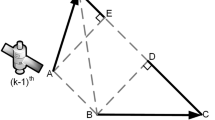Abstract
Spoofing in the form of transmitting fake GNSS signals is a deliberate attack that aims to mislead GNSS receivers into generating false position/time solutions. Current work on GNSS spoofing has mainly focused on spoofing detection where the proposed algorithms only indicate the presence of spoofing attacks. A new architecture consisting of spoofing detection, authentic/spoofing signal classification and spoofing cancelation known as spoofing detection, classification and cancelation for moving GNSS receivers is proposed. Predespreading and acquisition level analysis are performed to detect the presence of spoofing interference. The receiver motion is then used to classify the signals tracked into two groups, namely spoofing and authentic signal sets. A successive spoofing cancelation method is then developed to remove the spoofing signals from the raw digitized samples. It is shown that canceling out the spoofing signals removes multiple access interference and significantly improves the authentic signals’ detectability and tracking performance. Finally, after spoofing cancelation, authentic signals are acquired and tracked and their corresponding measurements are passed to a PVT engine for a reliable position solution. The proposed receiver architecture is analyzed in the acquisition, tracking and positioning layers.













Similar content being viewed by others
References
Akos DM (2012) Who’s afraid of the spoofer? GPS/GNSS spoofing detection via automatic gain control (AGC). Navigation 59(4):281–290
Broumandan A, Jafarnia A, Dehghanian V, Nielsen J, Lachapelle G (2012) GNSS spoofing detection in handheld receivers based on signal spatial correlation. Proc. IEEE/Ion Plans, Myrtle Beach, South Carolina, pp. 479–487
Daneshmand S, Jafarnia A, Broumandan A, Lachapelle G (2012) A low-complexity GPS anti-spoofing method using a multi-antenna array. Proc. ION GNSS 2012, Institute of Navigation, Nashville TN, pp. 1233–1243
Duel-Hallen A, Holtzman J, Zvonar Z (1995) Multiuser detection for CDMA systems. Proc. IEEE Pers Commun 46–58
Glennon EP, Dempster AG (2004) A review of GPS cross correlation mitigation techniques. In Proceedings 2004 International Symposium on GPS/GNSS, Sydney, Australia
Humphreys TE, Ledvina BM, Psiaki ML, O’Hanlon BW, Kintner PM (2008) Assessing the spoofing threat: development of a portable GPS civilian spoofer. In Proceedings of ION GNSS 2008, Institute of Navigation, Savannah, GA, pp. 2314–2325
Jafarnia A (2013) GNSS signal authenticity verification in the presence of structural interference. PhD Thesis, Report No. 20385, Department of Geomatics Engineering, University of Calgary
Jafarnia A, Daneshmand S, Broumandan A, Nielsen J, Lachapelle G (2013) PVT solution authentication based on monitoring the clock state for a moving GNSS receiver. In Proceedings of European Navigation Conference (ENC2013). Vienna, Austria, p. 11
Jafarnia A, Broumandan A, Nielsen J, Lachapelle G (2014) Pre-despreading authenticity verification for GPS L1 C/A signals. Navigation 61(1):1–11
Kaplan E, Hegarty CJ (2006) Understanding GPS: principles and applications. Artech House Publishers, London
Kay SM (1998) Fundamentals of statistical signal processing: detection theory. Prentice Hall, Upper Saddle River
Lopez-Risue G, Seco-Granados G (2005) CN0 estimation and near-far mitigation for GNSS indoor receivers. Proc IEEE Veh Technol Spring Conf 4:2624–2628
Madhani PH, Axelrad P, Krumvieda K, Thomas J (2003) Application of successive interference cancellation to GPS pseudolite near-far problem. IEEE Trans Aerosp Electron Syst 39(2):481–488
Mattos GP (2003) Solutions to the cross-correlation and oscillator stability problems for indoor C/A Code GPS Proc. ION GNSS 2003, Institute of Navigation, Portland, OR, pp. 654–659
McDowell CE (2007) GPS spoofer and repeater mitigation system using digital spatial nulling. US Patent 7250903 B1, p. 7
Montgomery PY, TE Humphreys, Ledvina BM (2009) Receiver-autonomous spoofing detection: experimental results of a multi-antenna receiver defense against a portable civil gps spoofer. In Proceedings ION ITM 2009, Institute of Navigation, Anaheim, CA, pp. 124–130
Moshavi S (1996) Multi-user detection for DS-CDMA communications. IEEE Commun Mag 34(10):124–136
Nielsen J, Broumandan A, Lachapelle G (2011) GNSS spoofing detection for single antenna handheld receivers. Navigation 58(4):335–344
Nielsen J, Dehghanian V, Lachapelle G (2012) Effectiveness of GNSS spoofing countermeasure based on receiver CNR measurements. Int J Navig Obs 501679:9
O’Brien AJ, Gupta IJ (2011) Mitigation of adaptive antenna induced bias errors in GNSS receivers. IEEE Trans Aerosp Electron Syst 47(1):524–538
Petovello M, O’Driscoll C, Lachapelle G, Borio D, Murtaza H (2008) Architecture and benefits of an advanced GNSS software receiver. J Glob Position Syst 7(2):156–168
Proakis J, Salehi M (2005) Fundamentals of communication systems. Prentice Hall Inc, Upper Saddle River
Psiaki ML, Powell SP, O’Hanlon BW (2013) GNSS spoofing detection using high-frequency antenna motion and carrier-phase data. In Proceedings ION GNSS 2013, Institute of Navigation, Nashville, TN, pp. 2949–2991
Scott L (2003) Anti-spoofing and authenticated signal architectures for civil navigation systems. In Proceedings ION GPS/GNSS 2003, Institute of Navigation, Portland, OR, pp. 1543–1552
Van Dierendonck AJ (2002) Determination of C/A code self-interference using cross-correlation simulations and receiver bench tests. In Proceedings ION GPS 2002, Institute of Navigation, Portland OR, pp. 630–642
Wen H, Huang PY, Dyer J, Archinal A, Fagan J (2005) Countermeasures for GPS signal spoofing. In Proceedings ION GNSS 2005, Institute of Navigation, Long Beach, CA, pp. 1285–1295
Author information
Authors and Affiliations
Corresponding author
Rights and permissions
About this article
Cite this article
Broumandan, A., Jafarnia-Jahromi, A. & Lachapelle, G. Spoofing detection, classification and cancelation (SDCC) receiver architecture for a moving GNSS receiver. GPS Solut 19, 475–487 (2015). https://doi.org/10.1007/s10291-014-0407-3
Received:
Accepted:
Published:
Issue Date:
DOI: https://doi.org/10.1007/s10291-014-0407-3




